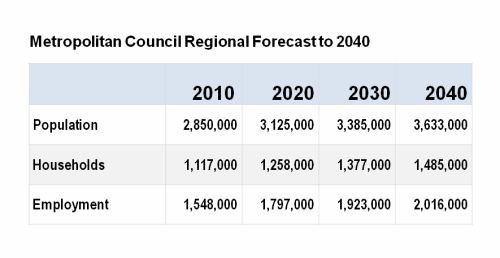With metro area cities and towns preparing to start their decennial local planning processes, the Metropolitan Council is fine-tuning its regional forecast. While the forecast of population, households, and employment to 2040 has been adjusted slightly downward since the 2014 release, the region will continue to grow in population and jobs.

According to the MetroStats report, “Steady Growth and Big Changes Ahead (pdf),” the Twin Cities region will add 783,000 residents between 2010 and 2040, and 468,000 more jobs.
The regional forecast was adjusted to reflect newer data and assumptions, including a slightly lower national employment forecast and lower birth rates.
Key regional forecast information
-
Regional population will top 3.6 million by 2040, with the highest rate of growth occurring before 2020, then slowing slightly.
-
Jobs will grow to more than 2 million by 2040.
-
Population will be more racially and ethnically diverse, older, and more likely to live alone.
-
Housing needs and preferences of older adults will reshape the housing market.
“Major demographic shifts are changing the face of the region,” said Libby Starling, Manager of Regional Policy and Research. “The region will be more racially and ethnically diverse and older. The aging population, combined with today’s smaller household sizes, will have significant implications for the preferences and demand for housing.”
Older households will shape housing market
Older adult households will account for 33% of all households in the region by 2040, compared to 17% in 2010. Starling says those older adult households are more likely to prefer attached housing like apartments, townhomes, or condominiums, to single-family housing.
 Furthermore, the number of working-age households has leveled off, and will grow only slightly. As a result, the demand for larger housing units for larger families may not grow substantially.
Furthermore, the number of working-age households has leveled off, and will grow only slightly. As a result, the demand for larger housing units for larger families may not grow substantially.
According to Council research:
-
The number of people of color will grow from 24% of the population in 2010 to 41% by 2040.
-
The age 65-and-older population will more than double, outpacing the growth in the working-age population.
-
The number of one-person households will grow to one-third of all households in the region by 2040.
Region will be much more racially and ethnically diverse
Also among the findings, the region’s workforce and school-age population will be more racially and ethnically diverse. By 2040, more than half the region’s children and young adults will be people of color; 58% and 53%, respectively.
According to Starling, steady job growth will continue to attract workers into the future. She says we can expect employment to grow more rapidly between 2010 and 2020, compared with the slower pace anticipated in the 2020s and 2030s; 7% and 5%, respectively.
Under state law, the Metropolitan Council prepares 30-year regional and local forecasts of population, households and employment. These regional and local forecasts provide a shared foundation for coordinated, comprehensive planning aligned between the Council and local governments.
This summer, the Council will update local forecasts to match the updated regional forecast totals, and to reflect improved local data.
More information
Like data? View more from Council Research.